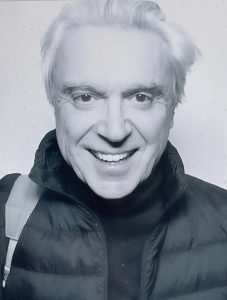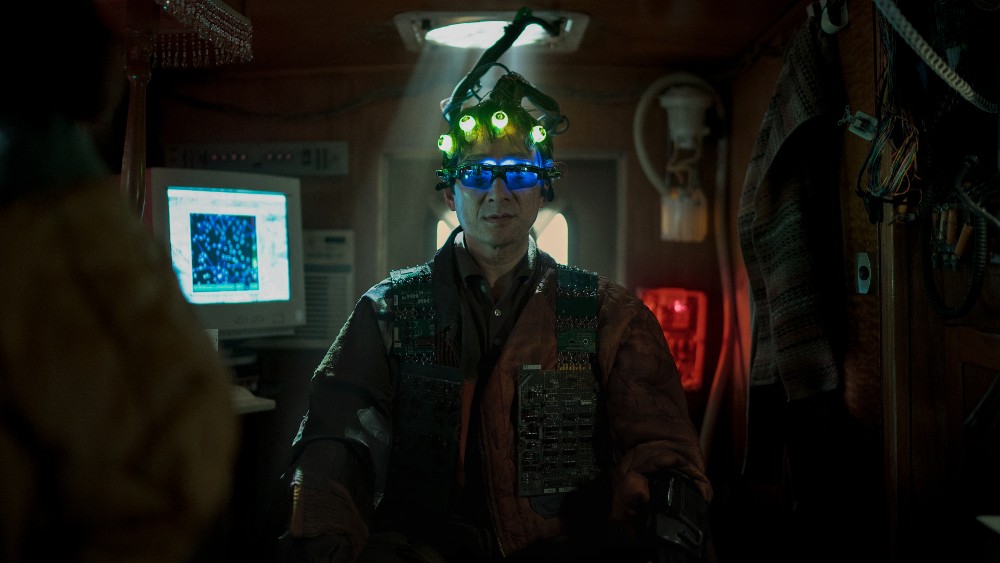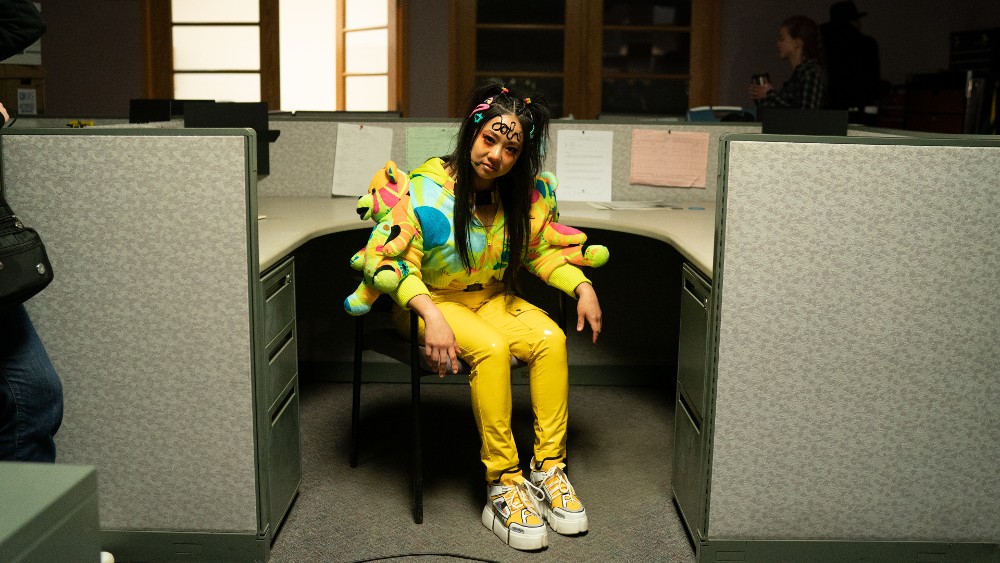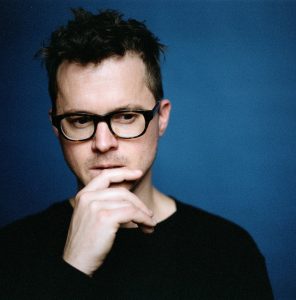Almost everything revolving around Daniels‘ Everything Everywhere All at Once seems like a small miracle of sorts, including how well it has performed this awards season, making it the unquestionable frontrunner in a number of Oscar races, both above and below the line.
Ryan Lott and his group, Son Lux, a three-piece experimental music group with Rafiq Bhatia and Ian Chang, were already well on their way to scoring Daniels’ film when it was suggested the movie might need a song. The idea was to do it with Japanese-American singer-songwriter Mitski, but then the third part of that collaboration ended up being David Byrne.
Most know Byrne from his 45 years making music, first with the Talking Heads, and then on his own, including his 10th studio album American Utopia, which led to a global tour in 2018 before it became a hit Broadway musical. Though it was a bit of a gamble to reach out to Byrne to collaborate, he eagerly signed on after seeing an early rough cut of the film, and he brought a great note to the collaboration.
In 12 days, Byrne and Son Lux will be performing their Oscar-nominated song “This Is a Life” at the Academy Awards along with Stephanie Hsu, the Oscar-nominated star of Everything Everywhere All at Once. Find out how the song came together in the following interview that Below the Line did over Zoom with Byrne and Lott, and stay tuned for a separate interview with Lott that focuses on the original score he composed with Son Lux.

Below the Line: David, how did you first get involved with writing this song? Did you know Ryan from your general musical circles?
David Byrne: Not really, but a little bit. I think we’d probably met at one point. I knew their manager, Michael Kaufman, because he worked with them, and I’m a fan of the band. There was a record label or company called Asthmatic Kitty, and they worked with Sufjan Stevens as well. That whole group, I got to know them through that. I don’t know where it came from, but I think it was Michael, their manager, who reached out to me and said, ‘Hey, we’re doing this score for this movie with the Daniels, and we’re looking for a song at the end. Are you interested?’ I don’t know if they told me right away, but then they said, ‘Oh, and we think it could be a duet with Mitski.’ Something like that.
Ryan Lott: That’s what we kept in our back pocket to sell it to you.
Byrne: The Daniels sent a rough viewing copy of the movie that didn’t have a lot of the effects and didn’t have the score. Of course, I was completely knocked out. You could see what it was going to be. It was very generous of them to do that. In a certain way, the song is for the end credits, but it actually did help to see it. From my point of view, I realized that this crazy, really trippy movie, actually, by the time you get to the end, you realize it’s got a lot of heart. It’s about redemption and forgiveness and this family that is squabbling the whole time, and then they finally make amends. It’s very sweet in ways you don’t expect. I thought it might be great if, as people are watching the credits and getting their coats, we [could] put a pin in that and remind them that in a certain way, this is what the movie was about. It’s actually more than just all the craziness and bagels and everything else.
Lott: That was David’s unique contribution at the very start of this, which was really a creative direction. When we first got on a Zoom call about it, I had already been dreaming up and hearing music in my head that was coming from a really different place. That was more of a party, more of a celebration. As soon as David expressed that insight that he just did here, I knew he was right. It really clicked. It’s like, David, you opened up the window to see the song, and the song really felt to me like it already existed. It was just a matter of finding that window to peer inside and discover it, and you gave that to us, so good job.
Byrne: Thank you.

BTL: Ryan, I assume you were fully into writing the score before the idea of a song came up. Did the Daniels throw that idea out there, or did you feel it needed a song at the end?
Lott: Daniels definitely wanted a song, but they were kind enough not to even ask us for it because we were in a mountain of cues. There are over 100 cues in the film — 100 unique moments of music, each one having to perform a number of tasks and weave together in a very specific way and overlap. There was so much puzzling and planning. The sheer volume of the work should have been our reason not to try to write a song, but…
Byrne: You managed to do it.
Lott: We did it, and honestly…
Byrne: A really, really sweet song. Mitski took, I guess, the initial melody and recorded that, and it was just perfect.
Lott: It was perfect, yeah.
Byrne: It just seemed to belong to her, and then I was faced with the task of, as Ryan said, ‘Can you do something that kind of weaves around that and speaks to what she’s saying?’ I thought, ‘Let me try this.’ I think there might have been a couple of attempts [at] writing a melody and some words that answered what she was saying, weaves around it, and I felt like I could maybe even get some words for some of the big explosive carts.
Lott: We never talked about that, actually, David, but that was a great idea as well because initially, I was just thinking they were like, [Makes an “awww” sound], and you came up with some great words for those moments.
Byrne: Thank you. I thought we could maybe tie that into the rest of the lyrics. We were all — as often happens these days — working in different places. I don’t know where you guys were all working, but I think Mitski is in San Francisco. I’m in New York. She might have been in Nashville, actually.
Lott: I was in Indianapolis, because…
Byrne: You were back in Indianapolis, because she moved to Nashville at some point.
Lott: I think so. I think that’s where she was or is. It’s such a weird world, man.
Byrne: I don’t picture her as a Nashville girl, but it is Music City, and what it’s about is a lot broader than what it used to be about.

BTL: Did either of you guys know Mitski beforehand, or did you all just meet to write and do this song?
Lott: No, I did not know her.
Byrne: I was a fan and really loved that in the performances she does, she comes up with this very interesting choreography. That’s what she’s doing, it’s very original.
Lott: The idea for Mitski came, not because we were friends or because we had worked together before, but because Daniel Kwan sent us his Spotify year-end screenshot. It was to make us feel good, because the three top artists were Son Lux, Ryan Lott — because I make music on my own as well — and Mitski. The first two can easily be explained by the fact that [he’s] listening to a lot of our music because he’s putting a lot of the music in the film, so he’s constantly playing new songs.
The only way to explain that third name is because he’s a big, big, big fan. Right? When he sent that over, we were like, ‘Yo! That’s who we should try to reach out to. Mitski would be perfect.’ We had always imagined a duet. It felt like it was a togetherness movie [and] it needed a togetherness song. And so, we spoke to her first, well before we knew anything, really. We actually set the idea aside. We had so many burners [and] so many pots, but she did the same thing David did. She saw a very early cut of it, and on the strength of how goddamn good this movie was, even already, at that early stage, she was like, ‘Sign me up. I’ll write, I’ll sing. Whatever [you] want, let’s just keep the dialogue going.’
Byrne: I remember watching the first 15 minutes or so of the rough cut and thinking, “Oh, this is really interesting. The Daniels did a movie that’s kind of a domestic drama about this family who owns a laundromat.” [laughs] And then it goes completely beyond the laundromat.

BTL: Ryan, had you written or demoed anything before David and Mitski got involved, or did just go on Zoom and throw ideas back and forth with each other?
Lott: I kind of led the initial charge, because I was just soaking in this movie for so long, just so many hours [each] day, and investigating it from so many different perspectives. It was like doing the workouts and all the cross-training, so when it came time to actually do the thing, it was quite simple, and it came so fast. I wrote the first draft of it sitting at a piano, just the primary vocal line and chord progressions. Fortunately, I have voice memos, because I knew I was gonna have to share it, so I [made] a voice memo [of] it. And, David, I don’t know if you know this, but in order to preserve… [the song] came so fast, right? And when something comes really fast, I always find it very important to never forget that initial feeling, that initial idea.
It’s one thing if you’ve winnowed it out slowly over time, and it kind of comes to life, carving a figure from a block of stone, but if you just walk around the corner and happen upon a statue carved in stone, that’s what it feels like to happen upon a musical idea. I think it’s really important not to screw it up, because it has this feeling like it already existed. So what I did, David, is when we were ready to create the actual version of the song, I took that original voice memo [and] I laid it into a sequencer, and I mapped every single beat so that I created a tempo map and a time map of the feeling of when I played the chords, how I played them, [and] the kind of breath and ebb and flow, in an attempt to preserve that very initial feeling. And then I learned the piano part again, and then removed the voice memo, and then played it to that click track. I had essentially recreated that very initial framework, and that was our starting point for building the fully-produced song.
BTL: David, when you and Mitski were recording your vocals, were you able to weigh in and give each other notes, or did you just record the vocals on your own and send the files back and forth?
Byrne: It was more getting the file and doing the vocals. I recalled that I did an early draft of some of the vocal lines that I was working on with some of the lyrics that I was working on and sent them to the guys and said, ‘Is this the direction that you’re thinking of?’ just to make sure — before I started polishing it and trying to get it so, as Ryan said, laid in with the beats — they’re kind of stretching and compressing and moving around in a really organic way. I had to be aware that it’s really about this breathing of the vocals around one another as opposed to this metronomic thing.
Lott: Actually, you and Mitski were opposite in that way. Mitski just kind of disappeared, and she was like, ‘I’m going to be recording on this day,’ and we were like, ‘Okay, that’s great. Good luck,’ and then a couple of days after that, she just sent the files, and here it is. And it was perfect. Her primary role was to sing what I had written for her to sing, but I want to be careful that we don’t shortchange the contribution she made, in addition to her performance, which [were] these ghostly “oohs” and “ahhs.” That was all her idea, and then the way she supported those big blasts.
It was her idea to incorporate the line [singing] “Tucked into a bagel” in her background vocals. She sent all of that, done, ready to go, like, “press play,” and it was perfect. But I love it. We all work [in] different ways. David, I loved getting scratch vocal tracks and ideas in our inbox from you, and I really appreciate [how] you opened up that process, [and] that you were generous in that you had open hands about it. I loved that vibe coming from you, [and] we all really appreciated that.
Byrne: Thank you.
BTL: David, I want to let you go, but you’ve been through the Oscar thing before…
Byrne: It’s been a very long time, but yes, I have done it once before — also a collaboration. So I’m kind of used to that, too. I do have to say that, although I can kind of tell just from the reaction of friends and people I know to the movie, I thought, “I think this movie is gonna get some nominations.” It’s not a huge, big studio movie, but people really like it, and maybe it’ll rub off on us. But I thought, “Oh, come on. Look at all these people who have these huge names who have songs out there.” And I thought, “It’s kind of a long shot for us to get nominated.” But, well, here we are.
Lott: The longest. [laughs]
Everything Everywhere All at Once is available on Showtime and all major VOD/digital platforms. Check back soon for the rest of our interview with Lott, in which he discusses Son Lux’s vibrant score.





